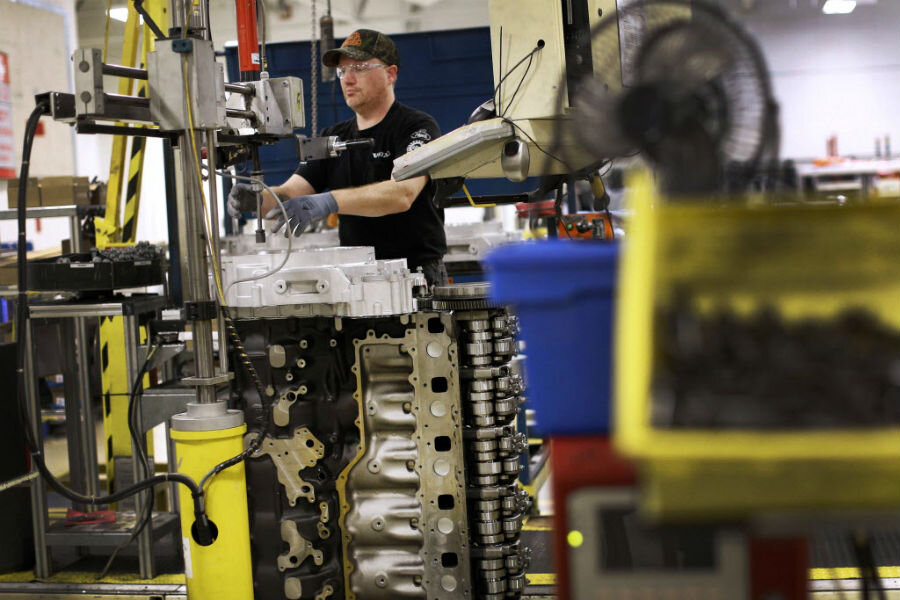White House hails rebound of US manufacturing, but is it for real?
Loading...
The mass exodus of millions of factory jobs overseas in the early 2000s brought the American manufacturing sector to its knees. However, since 2010, manufacturing has started to regain some footing, with more than 600,000 new jobs, according to a new report.
What’s more, many companies that outsourced production to China in the early 2000s are now considering rebuilding factories on US soil, according to a survey of manufacturing executives.
The Obama administration celebrated that growth in a series of press events this week as evidence that the US economy has turned a corner since the Great Recession. However, manufacturing experts suggest that declaration of victory might be premature.
A new report from the US National Economic Council, a White House agency, declared that American manufacturing is now more competitive than it has been in decades. As production has become more efficient with the advent of new technology, American manufacturers have been able to produce, boosting the sector’s growth even further.
“Manufacturing output has increased 30% since the end of the recession, growing at roughly twice the pace of the economy overall, marking the longest period where manufacturing has outpaced US economic output since 1965,” the report states.
While President Obama and his economic council have jubilantly reported an increase of 646,000 manufacturing jobs since 2010, included in the report, that increase is but a drop in the bucket compared with the mass exodus of manufacturing jobs seen in the decade prior, says Richard McCormack, editor and publisher of Manufacturing and Technology News.
“We suffered such a colossal loss of manufacturing jobs that we couldn’t really lose many more,” Mr. McCormack says. “We hit our nadir and we couldn’t really go down more than we had. So we’re really bouncing off the bottom.”
In 2000, there were more than 17 million manufacturing jobs in this country, according to the US Bureau of Labor Statistics. That number dropped to just 14 million by 2004 and plunged even further following the 2008 financial crisis. By 2010, there were just 11.5 million manufacturing jobs.
However, there is added promise in the news that many companies that outsourced production to China in the early 2000s are now considering rebuilding factories on US soil, according to a survey conducted by the international consulting firm Boston Consulting Group that was featured in the National Economic Council report.
When BCG researchers surveyed 100 senior executives in US-based industries ranging from textiles to electronics to metals fabrication at the beginning of 2012, only seven percent of respondents said that their companies were actively “re-shoring,” or relocating manufacturing back to the United States.
Eighteen months later, in a second survey, the number of respondents currently engaged in re-shoring nearly doubled to 13 percent, an increase that BCG statistician Hal Sirkin found so “astonishing” that he asked his team to poll another 100 executives from different companies to confirm that the survey had not yielded a statistical anomaly.
In total, more than half of those surveyed in 2013 said that their company was at least considering returning production to the US, up from just 37 percent in 2012. BCG estimates that revival could bring between 3.5 to 5 million jobs back to the US by the end of the decade, Mr. Sirkin says.
While the results startled Sirkin, they are in keeping with changes in the difference of labor costs between the US and China that has made Chinese labor less of a bargain, says Willy Shih, a business administration professor at Harvard Business School and author of “Producing Prosperity: Why America Needs a Manufacturing Renaissance.”
In the early 2000s, it cost manufactures an average of 10 times as much to employ a worker in the US as a worker in China, Mr. Shih says. That kind of differential left plenty of room for companies to cover the cost of shipping goods to the US.
However, as of the beginning of 2014, the average cost of labor in the US is only three times as expensive as in China. That’s a much smaller savings for companies to use to cover the added costs of shipping products halfway around the world, he says.
At the same time, the natural-gas boom in the US and the resulting low energy costs have attracted several European automakers to American shores, Shih says.
Mr. Obama has long emphasized that the key US global competitiveness lies in the strength of the American manufacturing sector.
“Our parents and our grandparents created the world’s largest economy and strongest middle class not by buying stuff, but by building stuff – by making stuff, by tinkering and inventing and building; by making and selling things first in a growing national market and then in an international market – stuff ‘Made in America,’ ” the president told attendees at a recent White House event.






